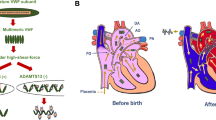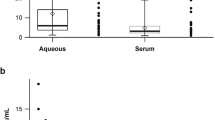Abstract
Background and purpose: The pathogenesis of thrombus formation in the retinal vein resulting in retinal vein occlusion is not well understood. This study was carried out to ascertain the role of hypercoagulable states in patients with retinal vein occlusion. Methods: Fifty seven consecutive patients with acute retinal vein occlusion (mean age 48 ± 11.5 years) were investigated for possible hypercoagulable states. Levels of antithrombin III (AT III), protein C (PC), Protein S (PS), factor XII, and fibrinogen as well as the presence of antiphospholipid antibodies (APAs) were investigated. The APAs and fibrinogen results obtained in these patients were compared to those of healthy controls. Results: We detected APAs in 15 out of 57 patients compared to 3 out of 74 controls (p = 0.0002). Fibrinogen levels were significantly higher in patients compared with the controls (p < 0; 0.001). Deficiencies in the naturally occurring anticoagulant proteins including AT III (4 out of 54 patients tested), PC (8 out of 42 patients tested), and PS (12 out of 56 patients tested) were detected. Seven patients out of 32 patients tested had reduced levels of factor XII. Subgroup analysis of the thrombophilic differences between patients who aged 45 years or less and older patients and patients with major trunk vein occlusion and patients with branch vein occlusion revealed no significant differences. Conclusion: Hypercoagulable states are common in patients with retinal vein occlusion and may contribute to the etiology of the disease.
Similar content being viewed by others
References
Green WR, Chan CC, Hutchins GM, Terry JM: Central retinal vein occlusion: A prospective histopathologic study of 29 eyes in 28 cases. Retina 1981; 1: 27–55.
Frangieh GT, Green WR, Barraquer-Somers E, Finkelstein D: Histopathologic study of nine branch retinal vein occlusions. Arch Ophthalmol 1982; 100: 1132–40.
Virchow R: Phlogose und Thrombose. In: Gesammelte Abhandlunger Zur Wissenschaftlichan Medizin, Van Meidlinger Sohn, Frankfurt, 1856, pp 458–636.
Bick RL, Pegram M: Syndromes of hypercoagulability and thrombosis: a review. Semin Thromb Hemost 1994; 20: 109–32.
Trope GE, Lowe GDO, McArdle BM, Douglas JT, Forbes CD, Prentice CM, Foulds WS: Abnormal blood viscosity and haemostasis in long-standing retinal vein occlusion. Br J Opthalmol 1983; 67: 137–42.
Peduzzi M, Codeluppi L, Poggi M, Baraldi P: Abnormal viscosity and erythrocyte deformability in retinal vein occlusion. Am J Ophthalmol 1983; 96: 399–400.
Arend O, Remky A, Jung F, Kiesewetter H, Reim M, Wolf S: Role of rheologic factors in patients with acute central retinal vein occlusion. Ophthalmology 1996; 103: 80–6.
Remky A, Arend O, Jung F, Kiesewetter H, Reim M, Sebastian W: Haemorheology in patients with branch retinal vein occlusion with and without risk factors. Graefe's Arch Clin Exp Ophthalmol 1996; 234: S8–S12.
Exner T, Rickard KA, Kroneberg H: A sensitive test demonstrating lupus anticoagulant and its behavioral pattern. Br J Haematol 1978; 40: 143–51.
Thiagarajan P, Pengo V, Shapiro SS: The use of dilute Russel viper venom time for the diagnosis of lupus anticoagulants. Blood 1986; 68: 869–74.
Triplett DA, Brandt JT, Kaczor D, Schaeffer J: Laboratory diagnosis of lupus inhibition: a comparison of the tissue thromboplastin inhibition procedure with a new platelet neutralization procedure. Am J Clin Pathol 1983; 79: 678–82.
Ellis BC, Stransky A: A quick and accurate method for the determination of fibrinogen in plasma. J Lab Clin Med 1961; 58: 477–88.
Bick RL, Baker WF: Antiphospholipid and thrombosis syndromes. Semin Thromb Hemost 1994; 20: 3–15.
McNell HP, Chesterman CN, Krilis SA: Anticardiolipin antibodies and lupus anticoagulants comprise separate antibody subgroups with different phospholipid binding characteristics. Br J Haematol 1989; 73: 506–13.
Coniglio M, Platania A, Di Nucci GD, Arcieri P, Modzrewska R, Mariani G: Antiphospholipid-protein antibodies are not an uncommon feature in retinal venous occlusions. Thromb Res 1996; 83: 183–8.
Bertram B, Haase G, Remky A, Reim M: Anticardiolipin antibodies in vascular occlusions of the eye. Ophthalmologe 1994; 91: 768–71.
Asherson RA, Merry P, Acheson JF, Harris EN, Hughes GR: Antiphospholipid antibodies: a risk factor for occlusive ocular vascular disease in systemic lupus erythematosus and the 'primary antiphospholipid syndrome'. Ann Rheum Dis 1989; 48: 358–61.
Glacet-Bernard A, Bayani N, Chretien P, Cochard C, Lelong F, Coscas G: Antiphospholipid antibodies in retinal vascular occlusions. A prospective study of 75 patients. Arch Ophthalmol 1994; 112: 790–5.
Messmore H, Fabbrini N, Hoppensteadt D, Larach F, Fareed J: Lupus anticoagulant assays. Semin Thromb Hemost 1994; 20: 79–88.
Vianna JL, Khamashta MA, Ordi-Ros J, Font I, Cerera R, Lpez-Soto A, Tolosa C, Franz J, Selva A, Ingelmo M, Vilardell M, Hughes GRV: Comparison of the primary and secondary antiphospholipid syndrome: a European multicenter study of 114 patients. Am J Med 1994; 96: 3–9.
Abu El-Asrar AM, Al-Momen AK, Al-Amro S, Abdel Gader AGM, Tabbara KF: Prothrombotic states associated with retinal venous occlusion in young adults. Int Ophthalmol 1996; 20: 197–204.
Shi W, Krilis SA, Chong BH, Gordon S, Chesterman CN: Prevalence of lupus anticoagulant and anticardiolipin antibodies in a healthy population. Aust NZJ Med 1990; 20: 231–6.
Lockwood CJ, Romero R, Feinberg RF, Clyne LP, Coster B, Hobbins JC: The prevalence and biologic significance of lupus anticoagulant and anticardiolipin antibodies in a general obstetric population. Am J Obstet Gynecol 1989; 161: 369–73.
Love PE, Santoro SA: Antiphospholipid antibodies: anticardiolipin and the lupus anticoagulant in systemic lupus erythematosus (SLE) and in non-SLE disorders. Prevalence and clinical significance. Ann Intern Med 1990; 112: 682–98.
Bick RL, Ancypa D: The antiphospholipid thrombosis (APL-T) syndromes. Clinical and laboratory correlates. Clin Lab Med 1995; 15: 63–84.
Ginsberg KS, Liang MH, Newcomer L, Golhaber SZ, Schur PH, Hennekens CH, Stampfer JM: Anticardiolipin antibodies and the risk for ischemic stroke and venous thrombosis. Ann Intern Med 1992; 117: 997–1002.
Levine SR, Crofts JW, Lesser GR, Floberg J, Welch KMA: Visual symptoms associated with the presence of lupus anticoagulant. Ophthalmology 1988; 95: 686–692.
Watts MT, Greaves M, Rennie 1G. Clearkin LG: Antiphospholipid antibodies in the aetiology of ischemic optic neuropathy. Eye 1991; 5: 75–9.
Kleiner RC, Najarian LV, Schatten S, Jabs DA, Patz A, Kaplan HJ: Vaso-occlusive retinopathy associated with antiphospholipid antibodies (lupus anticoagulant retinopathy). Ophthalmology 1989; 96: 896–904.
Galetta SL, Plock GL, Kushner MJ, Wyszynski RE, Brucker AJ: Ocular thrombosis associated with antiphospholipid antibodies. Ann Ophthalmol 1991; 23: 207–12.
Snyers B, Lambert M, Hardy J-P: Retinal and choroidal vaso-occlusive disease in systemic lupus erythematosus associated with antiphospholipid antibodies. Retina 1990; 10: 255–260.
Castañón C, Amigo M-C, Bañales JL, Nava A, Reyes PA: Ocular vaso-occlusive disease in primary antiphospholipid syndrome. Ophthalmology 1995; 102: 256–62.
Rosove MH, Brewer PMC: Antiphospholipid thrombosis: Clinical course after the first thrombotic event in 70 patients. Ann Intern Med 1992; 117: 303–8.
Prandoni P, Simioni P, Girolami A: Antiphospholipid antibodies, recurrent throm-boembolism, and intensity of warfarin anticoagulant. Thromb Haemost 1996; 75: 859.
Rance A, Emmerich J, Fiessinger J-N: Anticardiolipin antibodies and recurrent throboembolism. Thromb Haemost 1997; 77: 221–2.
Derksen RH, de Groot PG, Kater L, Nieuwenhuis HK: Patients with antiphospholipid antibodies and venous thrombosis should receive long term anticoagulant treatment. Ann Rheum Dis 1993; 52: 689–92.
Smith DB, Ens GE: Protein C deficiency: a cause of amaurosis fugax. J Neurol Neurosurg Psychiatr 1987; 50: 361–2.
Peduzzi M, De Rosa V, Fonda S, Coccheri S: Haemostatic studies in retinal vein occlusion. Fibrinolytic response to venostasis as a prognostic factor for spontaneous recanalization. Thromb Res 1981; 24: 105–18.
Bertram B, Remky A, Arend 0, Wolf S, Reim M: Protein C, Protein S, and antithrombin III in acute ocular occlusive diseases. German I Ophthalmol 1995; 4: 332–5.
Scat Y, Morin Y, Morel C, Haut I: Retinal vein occlusion and resistance to activated protein C. I Francais d Ophtalmologie 1995; 18: 758–62.
Speicher L, Philipp W, Kunz FJ: Factor XII deficiency and central retinal vein occlusion. Lancet 1992; 340: 237.
Patrassi GM, Mares M, Piermarocchi S, Santarossa A, Viero M, Girolami A: Fibrinollytic behavior in long-standing branch retinal vein occlusion. Ophthalmic Res 1987; 19: 221–5.
Jung F, Pindur G, Kiesewetter H: Plasma viscosity dependence on proteins and lipoproteins: results of the Aachen study. Clinical Hemorheol 1992; 12: 557–78.
Wiek I, Schade M, Wiederholt M, Arntz HR, Hansen LL: Haemorheological changes in patients with retinal vein occlusion after isovolaemic haemodilution. Br J Ophthalmol 1990; 74: 665–9.
Lowe GDO: Blood rheology in arterial disease. Clin Sci 1986; 771: 137–46.
Vine AK, Samama MM: The role of abnormalities in the anticoagulant and fibirnolytic systems in retinal vascular occlusions. Surv Ophthalmol 1993; 37: 283–92.
Author information
Authors and Affiliations
Rights and permissions
About this article
Cite this article
Abu El-Asrar, A.M., Abdel Gader, A.G.M., Al-Amro, S. et al. Hypercoagulable states in patients with retinal venous occlusion. Doc Ophthalmol 95, 133–143 (1998). https://doi.org/10.1023/A:1001795918894
Issue Date:
DOI: https://doi.org/10.1023/A:1001795918894




